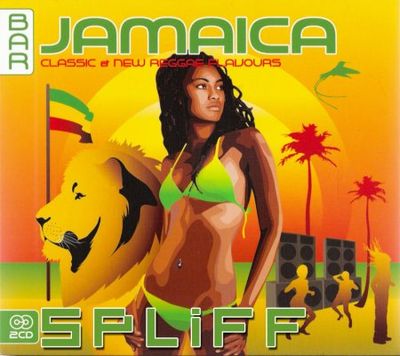VA - Made In Jamaica (2007) FLAC
2CD | tracks+CUE +LOG +SCANS | Year Of Release: July 30, 2007 | Label: Le Maquis | 850 MB
Genre: Reggae, Soundtrack, Dancehall
Tracklist:CD I : Reggae1. Bunny Wailer - 400 years (4:17)
2. Gregory Iscaacs - Kingston 14 (3:04)
3. Elephant Man - Hero (0:20)
4. Third World - 96° (4:39)
5. Bunny Wailer - Rastafari (0:33)
6. Capleton - That day will come (4:41)
7. Elephant Man - Stop war (0:13)
8. Toots and the Maytals - Love is the best (3:59)
9. Bunny Wailer - No woman no cry (3:38)
10. Joseph Current - You shattered my life (3:37)
11. Gregory Isaacs - Temptation (3:02)
12. Toots and the Maytals - 54-46 (4:48)
13. Shiah Coore and Cat Coore - Old man's soul (2:55)
14. Capleton - Fire burn (0:27)
15. Capleton - Jah is my everything (4:01)
16. Gregory Isaacs - The border (4:06)
17. Bunny Wailer - Bunny speak (0:10)
18. Bunny Wailer - I shot the sheriff (3:52)
19. Koolant - Rat race (1:23)
20. Joseph Current - Mr gunner man (3:10)
21. Tanya Stephen - Can't breathe (4:14)
22. Beres Hammond - Celevbrate life (3:51)
23. Toots and the Maytals - So excited (5:37)
CD II : Dancehall1. Lady Saw - France (3:23)
2. Elephant Man - Redemption song (0:56)
3. Elephant Man - Bootie bounce (3:27)
4. Lady Saw - Bad gal (3:04)
5. Elephant Man - Elephant man speak (0:22)
6. Bounty Killer - Red light zone (4:00)
7. Vibz Kartel - We a kill we (3:29)
8. Bounty Killer - No more suffering (3:28)
9. Vibz Kartel - Emergency (2:42)
10. Third World - Third world speak (0:52)
11. Bounty Killer - Talk to dem (3:13)
12. Vibz Kartel - Realest thing (3:05)
13. Blessed Stephens - Gangsta girl (2:47)
14. Doc Marshall - Deja vu (3:40)
15. Brick and Lace - Out of my mind (4:32)
16. Doc Marshall & Koolant - Girls (3:51)
17. Alaine Laughton - We can go (5:28)
18. Elephant Man - Jamaica national anthem (1:26)
This film (for those who have had the chance of seeing the film) is too much of a documentary and not enough of a musical exploration of the music itself which is the only aspect the CD shows. We do not need explanations that repeat what is in the songs. We can hear and if the songs are not necessarily in standard English, subtitles or printed translations can provide the understanding we need. They wrap up the music in settings that are so artificial that they are absurd. Songs recorded in a studio with frozen control-screens. Songs recorded in a kitchen or a bedroom. It adds nothing to the music, it adds nothing to our understanding and it brings no pleasurable extra dimension. But let's speak of the music and that is valid for both the film and the CD. Two tendencies appear very clearly. On one side the music that goes back to African traditions and the songs are committed to singing the heritage of slavery, the liberation of the blacks, the liberation of humanity beyond. It is also the assertion of a spirituality that they declare fundamentally Christian, though they seem to ignore at this moment the deeper non-Christian influence of the rastafari ideology that comes from Ethiopia - via Marcus Garvey - or even beyond the Vodun tradition (the old Voodoo of Hollywood) coming from West Africa. But this desire to be free as both individuals and a community is deeply human and universal and we can entirely enjoy and follow it. The second trend of these songs is coming from some men and most women. It is sexual in essence and it is the rare live stage scenes we are given in the film. It is visually aggressive in its anti-non-straight sexual relations and the postures and attitudes are explicitly sexually reducing the women dancers to some kind of brush used by the men to clean up the front of their pants. There is some change or rather evolution to introduce in that music for it to become sexually open and to advocate sexual freedom as much as racial freedom. But the music is superb. It is a music that has grown from the bringing together of two traditions, the European an the African traditions. The saxophone, the trumpet and the guitars are coming from Europe and the rhythms and rhythmic constructions are coming from Africa. Let me be very clear. Percussions are universal. The modern sets of drums used in amplified music and jazz are a specific American invention, including the blacks who have been in music since the very first day. But the rhythms used in Jamaican music, or all music coming from some African heritage, are typically African. You have a simple rhythm following the beats of the measure and that is the rhythm the singing follows, like normal dancers. But there is another rhythm behind and under, a lot faster, three or four times faster, that is frenetic and that some dancers can follow reaching the level of the trance typical of Vodun dancing. Listen to a solo of the drums in a jazz piece or concert and you will find this trance-rhythm made explicit. So the songs make the relation to Ethiopian ideology very clear, but does not make the relation to Vodun explicit, preferring a Christian reference which is at least reductive, though this tradition is obvious in the music even if it is not over-emphasized here. Listen to it and find that trance-like rhythm. And that is the typical and original musical African heritage that Jamaican music is using all the time.
Download From FileServe:Use
JDownloader to get Premium speed
 Comments (0)
All
Comments (0)
All










